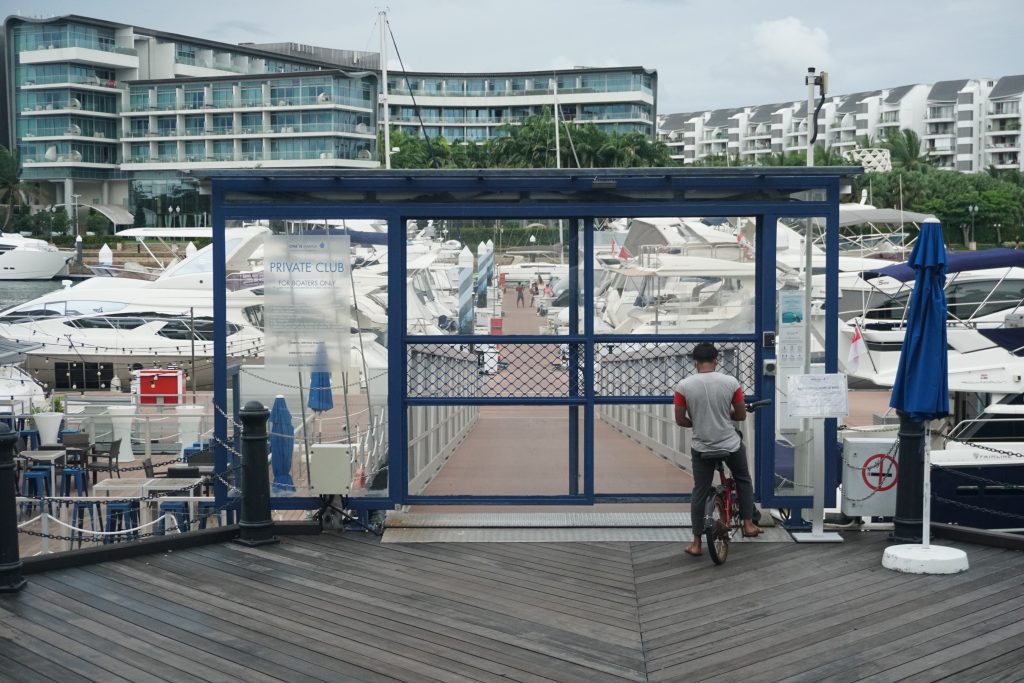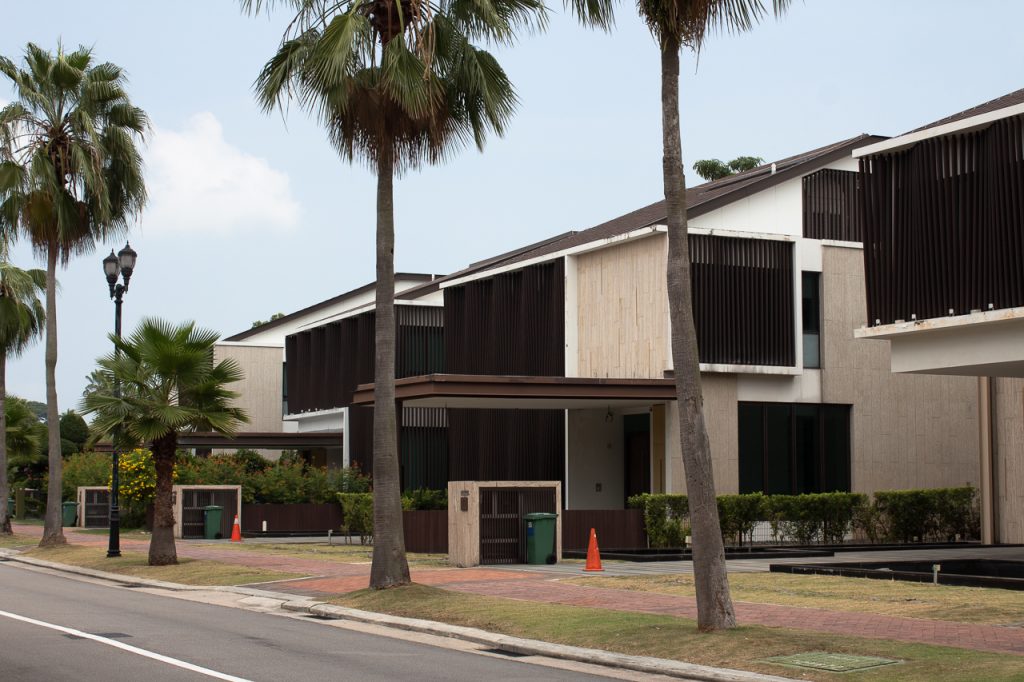Top image: Mansion in Sentosa Cove. Image by Cheryl Tang / RICE File Phote
I stand on a curb, looking at a mansion seemingly made only of windows. I can see through its entire living room, which looks onto a canal of water with direct access to a parked yacht.
“Gosh, such a big house but furnished with such horrid furniture,” I blurt out.
On my way to visit a friend, I continue cruising down Sentosa’s stretches of suburban roads lined with opulent mansions—some captivating, some just, well, tacky.
I can’t help but find myself picking each mansion apart, down to its tapestry and gardening.
“How ridiculous is it to have an entire marble exterior?”
“A fountain AND a chandelier?”
I pass one that looks like a small rendition of the Mummy ride at Universal Studios, decadently smothered in gold and adorned with two Egyptian Pharaohs guarding it’s door. Apparently, it’s the billionaire owner’s personal art gallery. He also owns a pirate-themed house allegedly designed by the same team that worked on Pirates of the Caribbean, which stores movie props from Disney.
Eventually, I pulled out my phone and continued my internal commentary on video, which I then posted as a TikTok later.
Reclaiming spaces online
What started out as a silly video for fun soon blew up to accrue over 250,000 views. Countless comments and DMs poured in requesting for more of such videos but in different neighbourhoods. So I made more, including one in Sixth Avenue which racked up almost 2 million views.
Though I branched out to mansions in different corners of Singapore, I kept coming back to the neighbourhood where I started. Sentosa Cove seems to attract a particular curiosity from viewers, and comments asking how I entered the place suggest that it’s due to the mystique that comes with a gated community. To put it simply, it’s essentially the only neighbourhood in the country that you can’t stroll leisurely into on your way to NTUC.
The series gives users a glimpse into this enclave and many others just like it, allowing the audience to engage with a space that has long been out of bounds to the hoi polloi.
By allowing anyone to laugh at the ultra-rich and their taste, many walls between us and them are momentarily removed.
This is not new though. I would argue that TikTok as an app is representative of this, as it uplifts the perspectives of everyday people. That doesn’t mean that you don’t see yachts, mansions, and jets on the app. You still do—but it’s usually from the lens of people outside the world of casual ordinariness.
This shift in the online space paints a hopeful future. One where we finally start caring less about status and wealth and more about what connects us and what we have in common.
It is a future in which we stop putting individuals on pedestals just because of material gain.
But as rosy as that sounds, the offline world is not headed in the same direction. Online, we’re alluded to thinking that we are uniting, but in reality, the inequality gap is only growing—something I noticed while filming my series.
I went back to Sentosa Cove three times over the past year, each time months apart, and I saw it evolve in a way I believe makes it a microcosm for the wider changes we are seeing today.
How the pandemic turned a ‘Poor Mans Bali’ into ‘Singapore’s Luxe Island Resort’
Before COVID, Sentosa Cove was eerily quiet.
In 2018, Bloomberg reported that house sellers at the Cove were “stomaching losses as steep as 40 per cent” after prices crashed compared to their 2011 highs. SCMP said the neighbourhood went “from Crazy Rich Asians to a poor man’s Bali.”
When I first filmed there, multiple mansions were uninhabited and left to decay. Many pools were empty, and moss blanketed the once sparkly white walls of these villas.
But as the pandemic progressed, this changed. I started seeing more people walking around, especially kids on bicycles and helpers with purebred dogs, and there were even more sports cars parked in driveways. I thought this was a result of how the pandemic forced everyone to stay home, breathing new life into the neighbourhood.
While that could be partially true, I wondered if the bigger reason may have more to do with the sudden increase of wealthy individuals moving to Singapore throughout the past year.
In May, Bloomberg announced that Singapore is the new preferred destination for the region’s ultra-rich, citing the poor handling of the pandemic around Southeast Asia and the political turmoil in Hong Kong as potential reasons.
As the wealthy people poured in, Sentosa Cove’s reputation started changing. SCMP was now calling the neighbourhood “Singapore’s luxe island resort” that was experiencing an influx of buyers.
And it did—Sentosa Cove saw more property sales in the first half of 2021 alone than in 2020.
As the only address in Singapore where foreigners can buy landed houses, it’s only logical that the foreign rich would flock to the little island. Competition here is tense with only 350 landed properties available for sale.
To some, this may be perceived as a win, or proof that what seemed like a failed real-estate experiment was in fact a success. But it’s also proof of the nebulous future of Singapore’s demographic, especially when it comes to wealth and immigration.
Ultra-rich foreigners flock in, and other foreigners leave

Over the past year, Singapore registered record dips in its population numbers. The decline comes largely from the 10.7% decrease in the foreigner population. This comes after 200,000 foreigners left in 2020 alone.
So while the foreigner population number is drastically lower now, the Bloomberg report suggests that the number of ultra-rich foreigners has actually increased. What then does this mean for integration?
In May, I wrote about Masha, a Russian immigrant who lived in Singapore for 17 years. She went to Loyang Primary School, graduated here, built her career here, saw her boyfriend go through NS, and built a support network in the local community.
She is as local as it gets, but she still decided to leave after being rejected for Permanent Residency (PR) nine times. On the flipside, there are schemes like the Global Investors Program that give the ultra-rich a fast track to gaining Permanent Residency (PR) in Singapore.
In 2019, a poll found that most Singaporeans feel that immigrants don’t do enough to integrate—but will this get any better now? Will the newly welcomed foreigners snatching up Sentosa Cove homes be able to integrate in better ways than those that have been leaving over the past two years, like Masha?
Wealth disparity grows in Singapore and around the world
Beyond the foreigner population, the shiny mansions featured on my TikTok also tell the tale of how wealth concentration is changing throughout the country.
As Sentosa Cove witnesses an uptick in foreign interest, it is still local citizens that comprise more than half of potential buyers. Beyond Sentosa’s shores too, the sales of Good Class Bungalows (GCBs)—which can usually only be bought by citizens—are soaring.
This uptick in the local mansion market could be a symptom of the worldwide growth in wealth disparity.
Internationally, the pandemic made billionaires richer. It also created 5.2 million more millionaires in 2020. And as writer Elgin Seah points out, Singapore attracts these wealthy individuals by offering a maximum capital gains tax of 0% (as compared to 20% in the United States).
Unlike income tax, a capital gains tax also incorporates income that derives from assets such as the sale of stocks, property or inheritance—all things the ultra-rich usually have an abundance of.
Currently, the top 1% in Singapore control 34% of all wealth in the country, compared to 18% in Japan, 24% in South Korea and 28% in Taiwan. That percentage may only grow bigger as the number of millionaires in Singapore continues to grow.

Social media and the impression of control?
Online, the house rating series is a place for regular people to engage with spaces they are often excluded from. And the good part about this is that it’s part of a wider trend, as more spaces online, like TikTok, are changing who society venerates and puts on pedestals.
This new model of social media shifts away from the likes of Instagram, for example, where the most followed and acclaimed users are international celebrities, the ultra-rich, and influential individuals. On TikTok, the biggest creators are often everyday users making relatable videos.
In fact, people enjoyed how TikTok was initially spared the grating presence of elite culture. When celebrities started joining the app in 2020, they were blamed for “ruining” the sanctity of TikTok and for using lame attempts to achieve virality.
But as social media moves in this promising direction, we can’t afford to lose touch with reality. We can’t let it distract us from the bigger changes happening around us, especially when they are in stark contrast to the shifts we applaud online.
If we want to build bridges and see the divide between communities physically decrease, we will need to take our action offline, and push for policy changes internationally and locally.
But we shouldn’t be discouraged either. Online, there’s already a palpable shift in ethos where our obsession with wealth and the wealthy is being swapped out for a preference for relatability and accessibility. It’s a big win, which, with the test of time may eventually seep into our physical reality and hopefully, create permanent structural changes worth celebrating.






